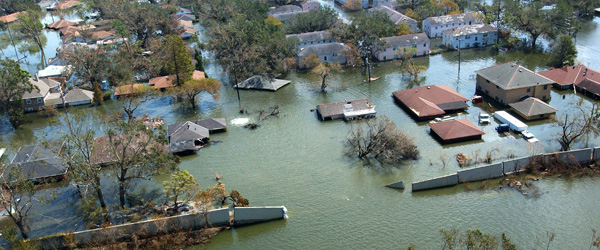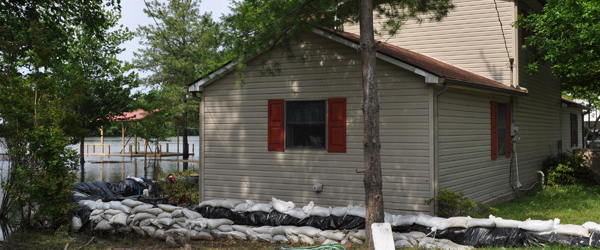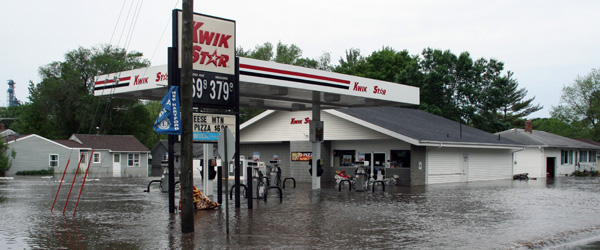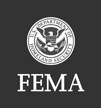 Before a Flood
Before a Flood
What would you do if your property were flooded? Are you prepared?
Even if you feel you live in a community with a low risk of flooding, remember that anywhere it rains, it can flood. Just because you haven't experienced a flood in the past, doesn't mean you won't in the future. Flood risk isn't just based on history; it's also based on a number of factors including rainfall , topography, flood-control measures, river-flow and tidal-surge data, and changes due to new construction and development.
Flood-hazard maps have been created to show the flood risk for your community, which helps determine the type of flood insurance coverage you will need since standard homeowners insurance doesn't cover flooding. The lower the degree of risk, the lower the flood insurance premium.
In addition to having flood insurance, knowing following flood hazard terms will help you recognize and prepare for a flood.
To prepare for a flood, you should:
- Build an emergency kit and make a family communications plan.
- Avoid building in a floodplain unless you elevate and reinforce your home.
- Elevate the furnace, water heater and electric panel in your home if you live in an area that has a high flood risk.
- Consider installing "check valves" to prevent flood water from backing up into the drains of your home.
- If feasible, construct barriers to stop floodwater from entering the building and seal walls in basements with waterproofing compounds.
Tropical Storms and Hurricanes - Hurricanes pack a triple punch: high winds, soaking rain, and flying debris. They can cause storm surges to coastal areas, as well as create heavy rainfall which in turn causes flooding hundreds of miles inland. While all coastal areas are at risk, certain cities are particularly vulnerable and could have losses similar to or even greater than those caused by the 2005 hurricane, Katrina, in New Orleans and Mississippi.
When hurricanes weaken into tropical storms, they generate rainfall and flooding that can be especially damaging since the rain collects in one place. In 2001, Tropical Storm Allison produced more than 30 inches of rainfall in Houston in just a few days, flooding over 70,000 houses and destroying 2,744 homes.
Spring Thaw - During the spring, frozen land prevents melting snow or rainfall from seeping into the ground. Each cubic foot of compacted snow contains gallons of water and once the snow melts, it can result in the overflow of streams, rivers, and lakes. Add spring storms to that and the result is often serious spring flooding.
Heavy Rains - Several areas of the country are at heightened risk for flooding due to heavy rains. The Northwest is at high risk due to La Niña conditions, which include snowmelts and heavy rains. And the Northeast is at high risk due to heavy rains produced from Nor'easters. This excessive amount of rainfall can happen throughout the year, putting your property at risk.
West Coast Threats - Although floods can occur throughout the year, the West Coast rainy season usually lasts from November to April. This window increases the chance of heavy flooding and flash flood risks.
Wildfires have dramatically changed the landscape and ground conditions on the West Coast, causing fire-scorched land to develop in to mudflows under heavy rain. Experts believe it will take years for the vegetation to be fully restored, which in turn will help stabilize these areas.
In addition to the heavy rains and wildfires, the West Coast has thousands of miles of levees, which were constructed to help protect homes and land in case of a flood. However, levees are not fail-proof and can, weaken, or overtop when waters rise, often causing catastrophic results.
 Levees & Dams - Levees are designed to protect hold back a certain level of water. However, levees can and do fail; and when they fail, they can fail catastrophically. Weakening of levees over time, or as a result of weather events exceeding the levee’s level of support, can cause the levee to be overtopped or breached, thus increasing the chance for flooding. Homeowners and renters insurance policies usually do not cover flood loss, therefore FEMA strongly encourages those who live and work behind levees to consider flood insurance as a dependable financial security from a flood event
Levees & Dams - Levees are designed to protect hold back a certain level of water. However, levees can and do fail; and when they fail, they can fail catastrophically. Weakening of levees over time, or as a result of weather events exceeding the levee’s level of support, can cause the levee to be overtopped or breached, thus increasing the chance for flooding. Homeowners and renters insurance policies usually do not cover flood loss, therefore FEMA strongly encourages those who live and work behind levees to consider flood insurance as a dependable financial security from a flood event
Flash Floods - Flash floods are the #1 weather-related killer in the U.S. since they can roll boulders, tear out trees, and destroy buildings and bridges. A flash flood is a rapid flooding of low-lying areas in less than six hours, which is caused by intense rainfall from a thunderstorm or several thunderstorms. Flash floods can also occur from the collapse of a man-made structure or ice dam.
New Development - Construction and development can change the natural drainage and create brand new flood risks. That's because new buildings, parking lots, and roads mean less land to absorb excess precipitation from heavy rains, hurricanes, and tropical storms.
Familiarize yourself with these terms to help identify a flood hazard:
Flood Watch - Flooding is possible. Tune in to NOAA Weather Radio, commercial radio or television for information.
Flash Flood Watch - Flash flooding is possible. Be prepared to move to higher ground; listen to NOAA Weather Radio, commercial radio or television for information.
Flood Warning - Flooding is occurring or will occur soon; if advised to evacuate, do so immediately.
Flash Flood Warning - A flash flood is occurring; seek higher ground on foot immediately.
The following are important points to remember when driving in flood conditions:
- Six inches of water will reach the bottom of most passenger cars causing loss of control and possible stalling.
- A foot of water will float many vehicles
- Two feet of rushing water can carry away most vehicles including sport utility vehicles (SUV’s) and pick-ups.
- Do not attempt to drive through a flooded road. The depth of water is not always obvious. The road bed may be washed out under the water, and you could be stranded or trapped.
- Do not drive around a barricade. Barricades are there for your protection. Turn around and go the other way.
- Do not try to take short cuts. They may be blocked. Stick to designated evacuation routes.
- Be especially cautious driving at night when it is harder to recognize flood dangers.
 During a Flood
During a Flood
If a flood is likely in your area, you should:
- Listen to the radio or television for information.
- Be aware that flash flooding can occur. If there is any possibility of a flash flood, move immediately to higher ground. Do not wait for instructions to move.
- Be aware of stream, drainage channels, canyons and other areas known to flood suddenly. Flash floods can occur in these areas with or without typical warnings such as rain clouds or heavy rain.
If you must prepare to evacuate, you should do the following:
- Secure your home. If you have time, bring in outdoor furniture. Move essential items to an upper floor.
- Turn off utilities at the main switches or valves if instructed to do so. Disconnect electrical appliances. Do not touch electrical equipment if you are wet or standing in water.
If you have to leave your home, remember these evacuation tips:
- Do not walk through moving water. Six inches of moving water can make you fall. If you have to walk in water, walk where the water is not moving. Use a stick to check the firmness of the ground in front of you.
- Do not drive into flooded areas. If floodwaters rise around your car, abandon the car and move to higher ground if you can do so safely. You and the vehicle can be swept away quickly.
- Do not camp or park your vehicle along streams, rivers or creeks, particularly during threatening conditions.
After the Flood
Your home has been flooded. Although floodwaters may be down in some areas, many dangers still exist. Here are some things to remember in the days ahead:
- Use local alerts and warning systems to get information and expert informed advice as soon as available.
- Avoid moving water.
- Stay away from damaged areas unless your assistance has been specifically requested by police, fire, or relief organization.
- Emergency workers will be assisting people in flooded areas. You can help them by staying off the roads and out of the way.
- Play it safe. Additional flooding or flash floods can occur. Listen for local warnings and information. If your car stalls in rapidly rising waters, get out immediately and climb to higher ground.
- Return home only when authorities indicate it is safe.
- Roads may still be closed because they have been damaged or are covered by water. Barricades have been placed for your protection. If you come upon a barricade or a flooded road, go another way.
- If you must walk or drive in areas that have been flooded.
- Stay on firm ground. Moving water only 6 inches deep can sweep you off your feet. Standing water may be electrically charged from underground or downed power lines.
- Flooding may have caused familiar places to change. Floodwaters often erode roads and walkways. Flood debris may hide animals and broken bottles, and it's also slippery. Avoid walking or driving through it.
- Be aware of areas where floodwaters have receded. Roads may have weakened and could collapse under the weight of a car.
- Stay out of any building if it is surrounded by floodwaters.
- Use extreme caution when entering buildings; there may be hidden damage, particularly in foundations.
Staying Healthy
A flood can cause physical hazards and emotional stress. You need to look after yourself and your family as you focus on cleanup and repair.
- Avoid floodwaters; water may be contaminated by oil, gasoline or raw sewage.
- Service damaged septic tanks, cesspools, pits and leaching systems as soon as possible. Damaged sewer systems are serious health hazards.
- Listen for news reports to learn whether the community’s water supply is safe to drink
- Clean and disinfect everything that got wet. Mud left from floodwaters can contain sewage and chemicals.
- Rest often and eat well.
- Keep a manageable schedule. Make a list and do jobs one at a time.
- Discuss your concerns with others and seek help. Contact Red Cross for information on emotional support available in your area.
Cleaning Up and Repairing Your Home
- Turn off the electricity at the main breaker or fuse box, even if the power is off in your community. That way, you can decide when your home is dry enough to turn it back on.
- Get a copy of the book Repairing Your Flooded Home (737KB PDF) which is available free from the American Red Cross or your state or local emergency manager. It will tell you:
- How to enter your home safely.
- How to protect your home and belongings from further damage.
- How to record damage to support insurance claims and requests for assistance.
- How to check for gas or water leaks and how to have service restored.
- How to clean up appliances, furniture, floors and other belongs.
- The Red Cross can provide you with a cleanup kit: mop, broom, bucket, and cleaning supplies.
- Contact your insurance agent to discuss claims.
- Listen to your radio for information on assistance that may be provided by the state or federal government or other organizations.
- If you hire cleanup or repair contractors, check references and be sure they are qualified to do the job. Be wary of people who drive through neighborhoods offering help in cleaning up or repairing your home.
While spring brings the promise of warm weather and longer days, it also brings a variety of conditions that can include heavy rains, severe weather, and rapid snowmelt that can increase your flood risk.
Don't be caught off guard, get the facts and know the risks. Take action to protect yourself, your family, your business, and your finances—before a weather event occurs and it's too late.
Use the tools here to learn the steps you can take before, during and after a flood to prepare yourself and your family.
Interactive Flood Risk Resources
For more information about floods, risk of financial loss due to flooding, and flood insurance check out
Recommended Training
To promote Flood Safety Awareness, FEMA's Emergency Management Institute (EMI) has developed a series of training programs to encourage flood safety. This guide provides readers with an easy way to identify and access self-paced courses designed for people who have emergency management responsibilities and the general public.
Printer Friendly Information You Can Use & Share
FEMA has developed these resources to educate and inform communities about the importance of flood safety awareness. Regional information is available to help you get to know the risks in your area.
- What You Should Know About Spring Flooding: Risks and Protection
- Flood After Fire Fact Sheet
- Region II: New York and New Jersey
- Region III: DC, Delaware, Maryland, Pennsylvania, Virginia and West Virginia
- Region V: Illinois, Indiana, Michigan, Minnesota, Ohio and Wisconsin
- Region VI: Arkansas, Louisiana, New Mexico, Oklahoma and Texas
- Region VII: Iowa, Kansas, Missouri and Nebraska
- Region VIII: Colorado, Montana, North Dakota, South Dakota, Utah and Wyoming
Outreach Toolkit Materials
As a leader in public information response to emergency situations, the National Flood Insurance Program (NFIP) has developed this valuable tool designed to assist your efforts to educate and inform communities about the importance of flood insurance coverage.
 FEMA Publications
FEMA Publications
If you require more information about any of these topics, the following resources may be helpful.
Other Publications
National Weather Service
Related Websites
Find additional information on how to plan and prepare for floods and learn about available resources by visiting the following websites:
Listen to Local Officials
Learn about the emergency plans that have been established in your area by your state and local government. In any emergency, always listen to the instructions given by local emergency management officials.



